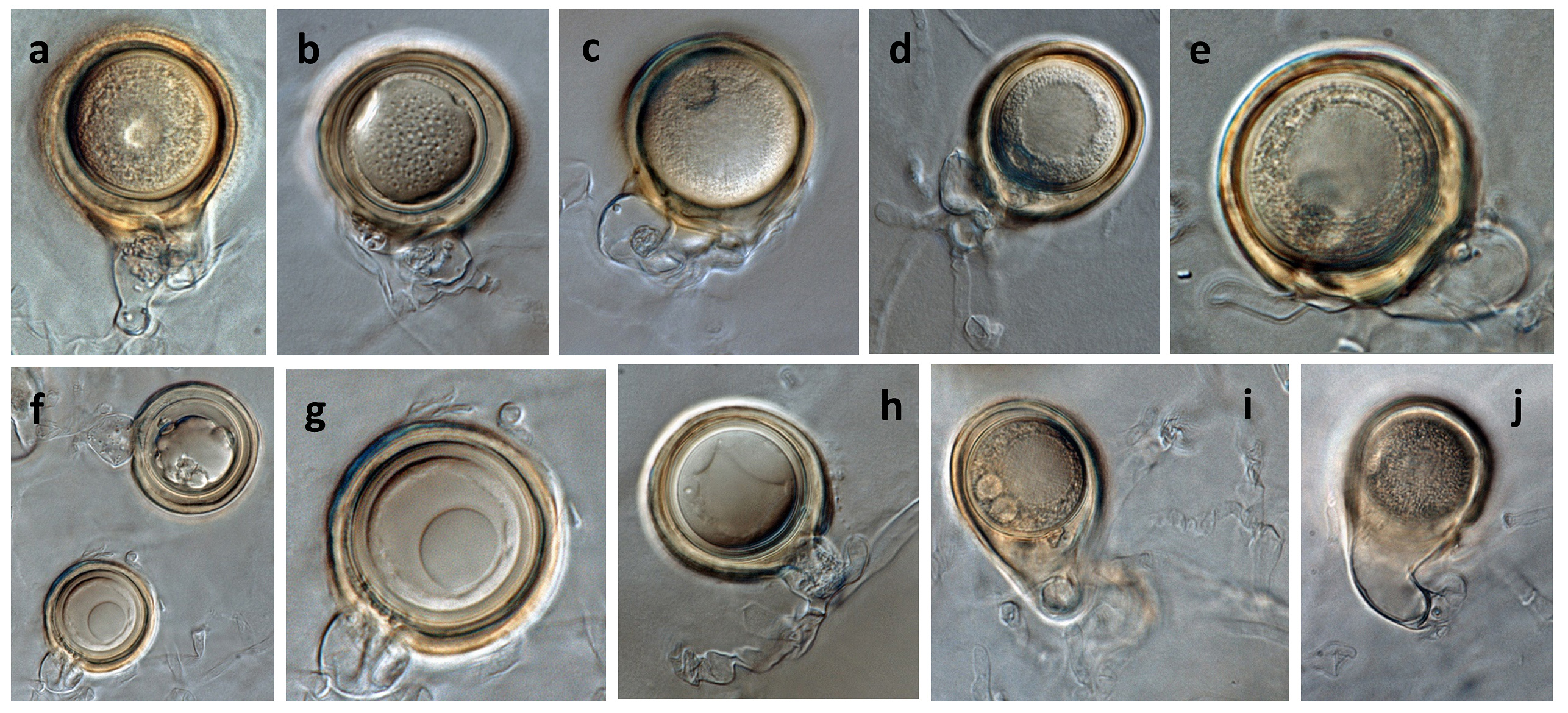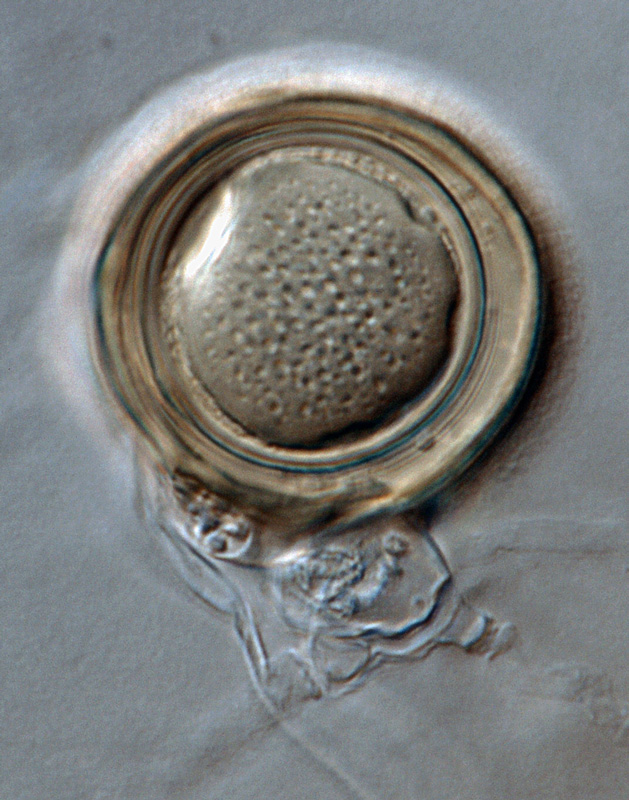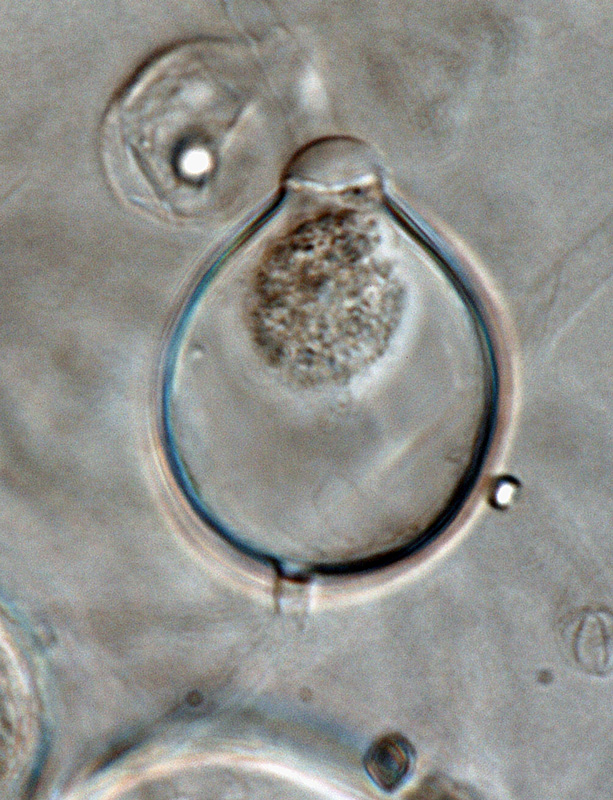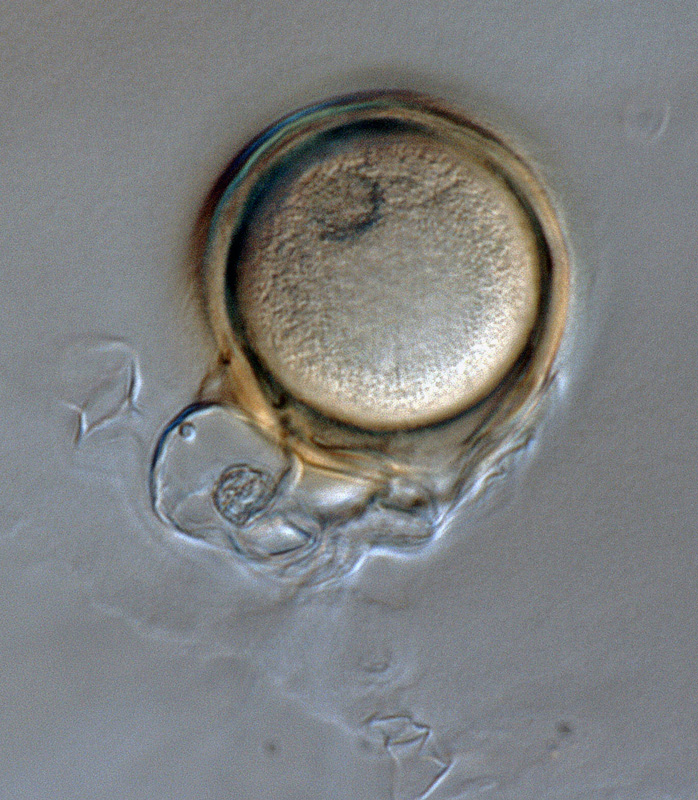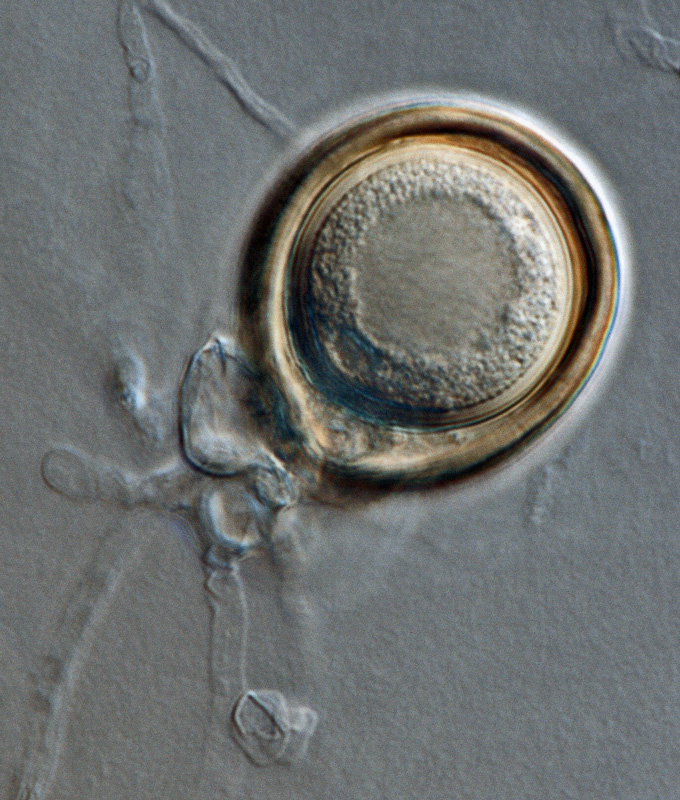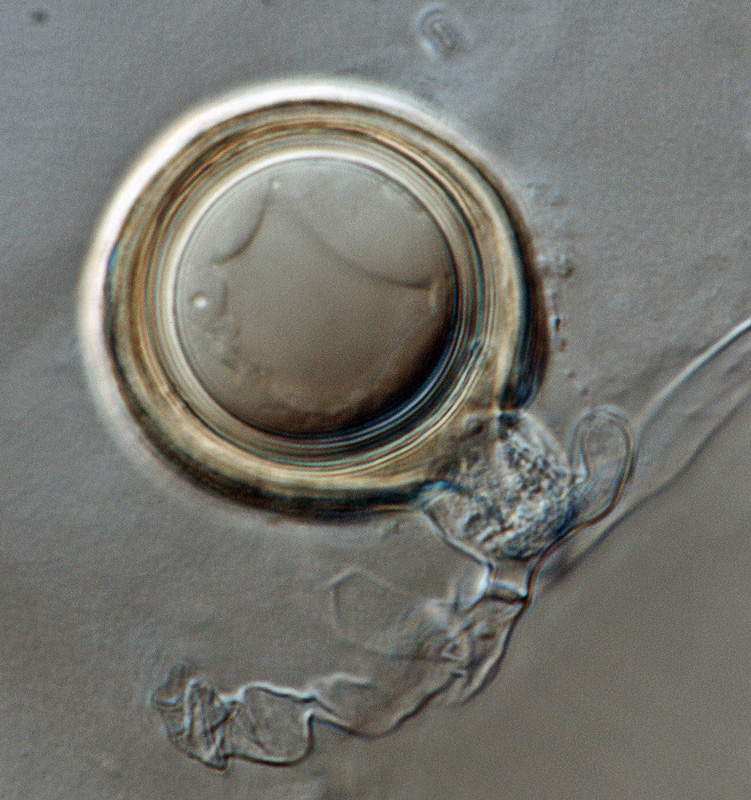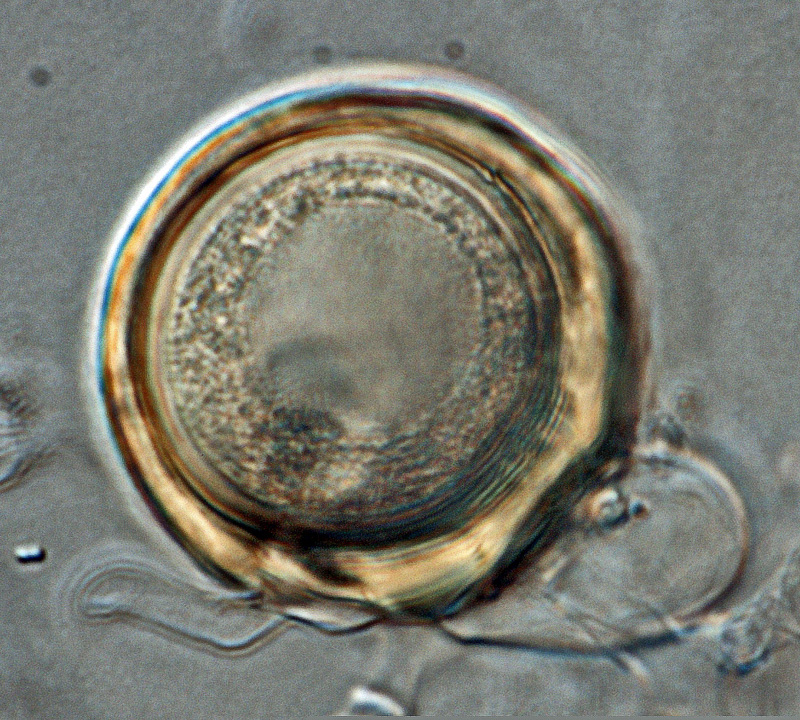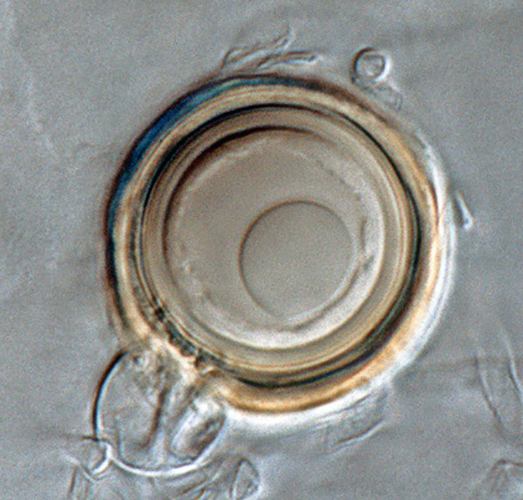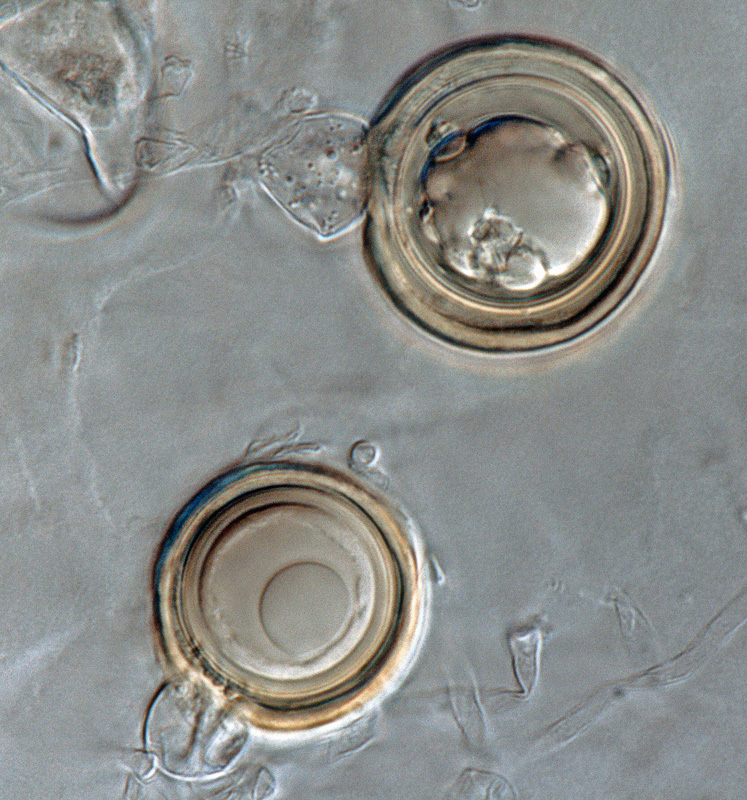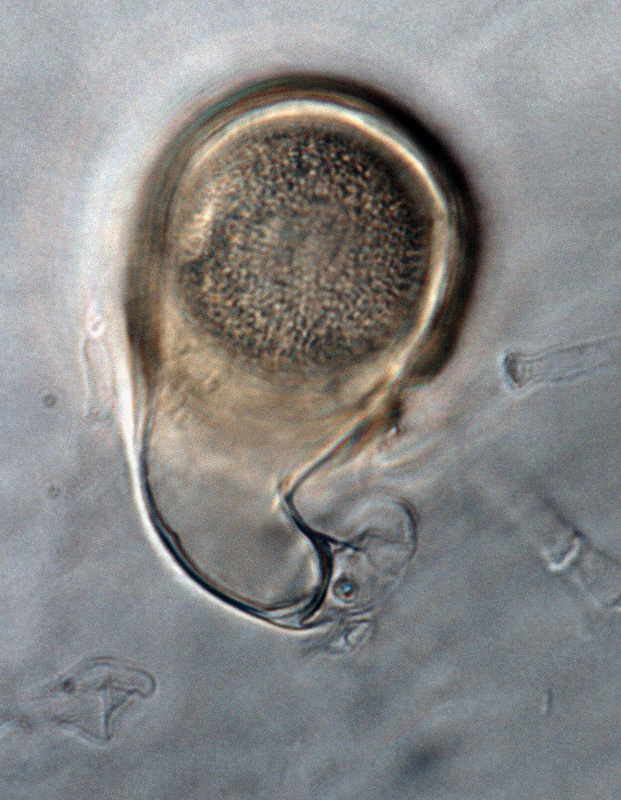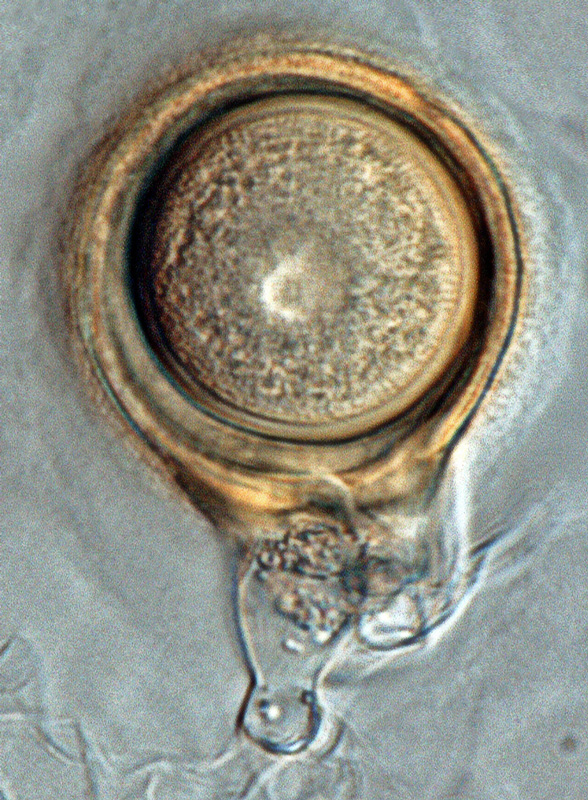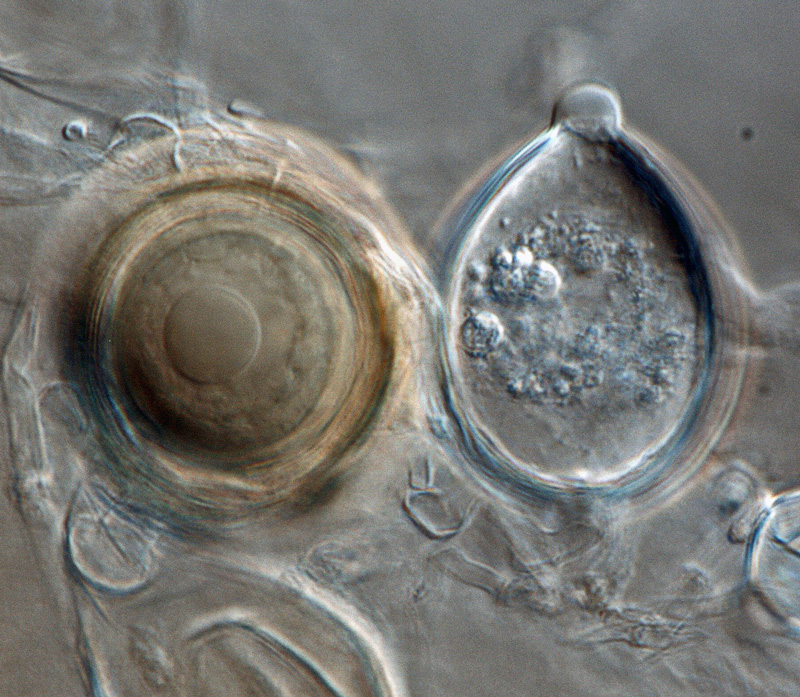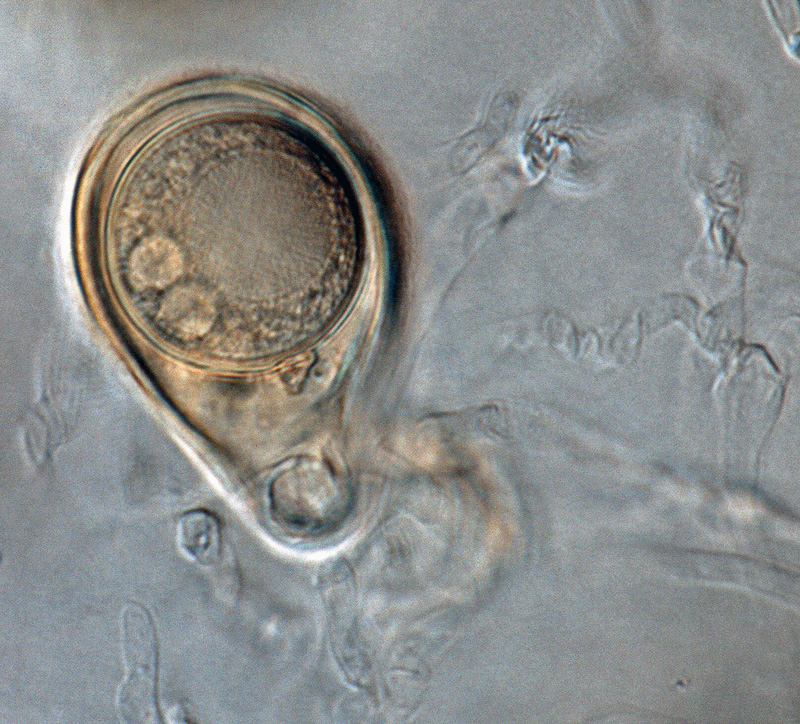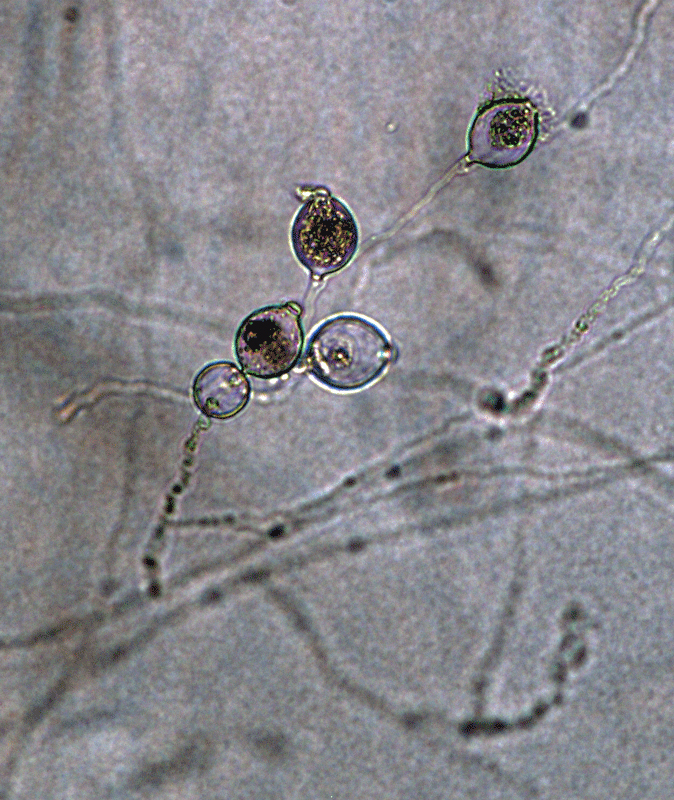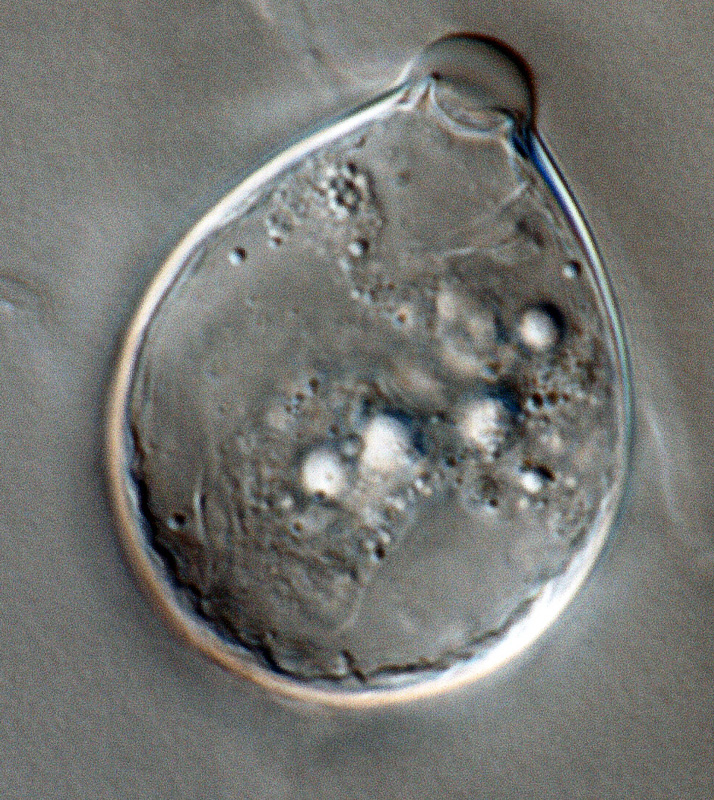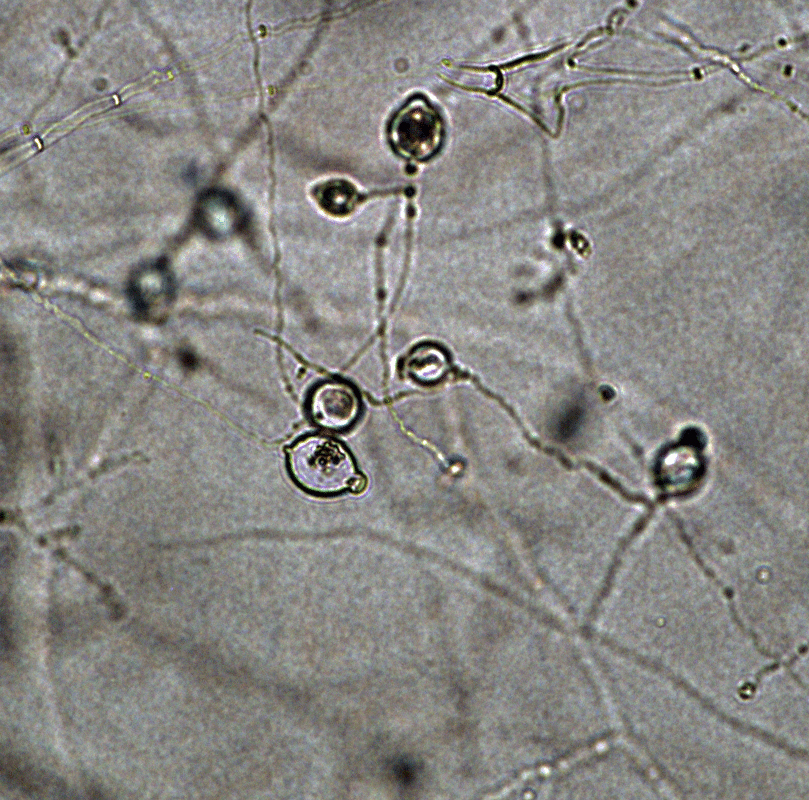Phytophthora idaei
|
Phytophthora spp. in subclade 1a: portion of the seven-loci ML phylogeny featuring the type cultures of 212 described species (by T. Bourret). Notice the position of P. idaei Ex-type CBS 971.95 = S&T BL 38. Gloria Abad, USDA S&T.
|
|
Phytophthora spp. in subclade 1a: Morphological Tabular key (PDF) and Tabular key legends (PDF) in IDphy2 KEY SECTION. Notice the data of P. idaei Ex-type CBS 971.95 = S&T BL 38. Gloria Abad, USDA S&T.
|
|
Phytophthora ideai (ex-type CPHST BL 38) asexual phase: (a–f) sporangia papillate, persistent, showing external proliferation (c) and produced in simple and in irregular lax sympodium sporangiophores (a, b); (f) papillate sporangium and gold oospore; photos by Gloria Abad, USDA-APHIS-PPQ. |
|
Phytophthora ideai (ex-type CPHST BL 38) sexual phase: (a–j) oogonia smooth-walled and sometimes pigmented when mature, sometimes with tapered bases (a, c, i, j) and often comma-shaped (i, j); antheridia predominantly paragynous, commonly attached near the oogonial stalk (a–i), and sometimes amphyginous (f–h); oospores plerotic (c, g) and aplerotic (a, b, h); photos by Gloria Abad, USDA-APHIS-PPQ. |
|
Phytophthora ideai (ex-type CPHST BL 38) sexual phase: smooth-walled, pigmented oogonium with paragynous antheridium; photo by Gloria Abad, USDA-APHIS-PPQ. |
|
Phytophthora ideai (ex-type CPHST BL 38) asexual phase: papillate sporangium; photo by Gloria Abad, USDA-APHIS-PPQ. |
|
Phytophthora ideai (ex-type CPHST BL 38) sexual phase: smooth-walled, pigmented oogonium with tapered base and paragynous antheridium; photo by Gloria Abad, USDA-APHIS-PPQ. |
|
Phytophthora ideai (ex-type CPHST BL 38) sexual phase: smooth-walled, pigmented oogonium with tapered base and paragynous antheridium; photo by Gloria Abad, USDA-APHIS-PPQ. |
|
Phytophthora ideai (ex-type CPHST BL 38) sexual phase: smooth-walled, pigmented oogonium with amphyginous antheridium; photo by Gloria Abad, USDA-APHIS-PPQ. |
|
Phytophthora ideai (ex-type CPHST BL 38) sexual phase: smooth-walled, pigmented oogonium with and paragynous antheridium; photo by Gloria Abad, USDA-APHIS-PPQ. |
|
Phytophthora ideai (ex-type CPHST BL 38) sexual phase: smooth-walled, pigmented oogonium with amphyginous antheridium; photo by Gloria Abad, USDA-APHIS-PPQ. |
|
Phytophthora ideai (ex-type CPHST BL 38) sexual phase: smooth-walled, pigmented oogonia with amphyginous antheridia; photo by Gloria Abad, USDA-APHIS-PPQ. |
|
Phytophthora ideai (ex-type CPHST BL 38) sexual phase: smooth-walled, comma-shaped, and pigmented oogonium with tapered base; photo by Gloria Abad, USDA-APHIS-PPQ. |
|
Phytophthora ideai (ex-type CPHST BL 38) sexual phase: smooth-walled, pigmented oogonium with tapered base and paragynous antheridium; photo by Gloria Abad, USDA-APHIS-PPQ. |
|
Phytophthora ideai (ex-type CPHST BL 38) sexual and asexual phases: pigmented oospore and papillate sporangium; photo by Gloria Abad, USDA-APHIS-PPQ. |
|
Phytophthora ideai (ex-type CPHST BL 38) sexual phase: smooth-walled, comma-shaped, and pigmented oogonium with tapered base and paragynous antheridium; photo by Gloria Abad, USDA-APHIS-PPQ. |
|
Phytophthora ideai (ex-type CPHST BL 38) asexual phase: persistent papillate sporangia produced in simple lax sympodium sporangiophores; photo by Gloria Abad, USDA-APHIS-PPQ. |
|
Phytophthora ideai (ex-type CPHST BL 38) asexual phase: papillate sporangium; photo by Gloria Abad, USDA-APHIS-PPQ. |
|
Phytophthora ideai (ex-type CPHST BL 38) asexual phase: persistent papillate sporangia produced in irregular lax sympodium sporangiophores; photo by Gloria Abad, USDA-APHIS-PPQ. |
|
Phytophthora ideai (ex-type CPHST BL 38) asexual phase: papillate sporangium with external proliferation; photo by Gloria Abad, USDA-APHIS-PPQ. |
Name and publication
Phytophthora idaei D.M. Kenn. (1995)
Kennedy DM and Duncan JM. 1995. A papillatepapillate:
pertaining to the production of a distinct papilla at the distal end of the sporangium (cf. nonpapillate and semipapillate)
Phytophthora species with specificity to Rubus. Mycol. Res. 99: 57–68.
Nomenclature
from Kennedy and Duncan (1995)
Mycobank
Etymology
named for the original host Rubus idaeus
Typification
Type: SCOTLAND, isolated from the roots of cultivated raspberries (Rubus idaeus) cv. Malling Leo collected by Kennedy in 1987; holotype: IMI 313728
Ex-type: SCRI R77 (Scottish Crop Research Institute); WPC: P6767, type strain. Received from Phil Hamm in 1989. Collected by D.M. Kennedy, Scottish Crop Research Institute, Invergowrie, Dundee, U.K., (SCRI R77, 1987), Location: UK, Scotland.
Ex-type in other collections
(ET) CBS 971.95, MYA-4065, WPC P6767, SCRI R77 (Duncan), S&T BL 38 (Abad), 34D4 (Hong), p220 (Gallegly), IDA3 (Cooke), PD 94/959
Molecular identification
Voucher sequences for barcoding genes (ITS rDNA and COI) of the ex-type (see Molecular protocols page)
Phytophthora idaei isolate CPHST BL 38 (= P6767 WPC) = ITS rDNA MG865509, COI MH136903
Voucher sequences for Molecular Toolbox with seven genes (ITS, β-tub, COI, EF1α, HSP90, L10, and YPT1
(see Molecular protocols page) (In Progress)
Voucher sequences for Metabarcoding High-throughput Sequencing (HTS) Technologies [Molecular Operational Taxonomic Unit (MOTU)]
(see Molecular protocols page) (In Progress)
Sequences with multiple genes for ex-type in other sources
- NCBI: Phytophthora idaei CPHST BL 38
- NCBI: Phytophthora idaei P6767
- NCBI: Phytophthora idaei CBS 971.95
- EPPO-Q-bank: Phytophthora idaei CBS 971.95
- BOLDSYSTEMS: Phytophthora idaei OOMYA245.07 = CBS 971.95, OOMYA517-08 = CBS 971.95, PHYTO202-10 = P6767 (barcoding COI & ITS)
Position in multigenic phylogeny with 7 genes (ITS, β-tub, COI, EF1α, HSP90, L10, and YPT1)
Clade clade:
a taxonomic group of organisms classified together on the basis of homologous features traced to a common ancestor
1a
Morphological identification
Colonies and cardinal temperatures
Colonies with very slow growth and with no obvious pattern in PDA, CMA, and V8A. The minimum temperature for growth is 3°C, optimum 18–24°C, and maximum 27°C.
Asexual phase
SporangiaSporangia:
sac within which zoospores form, especially when water is cooled to about 10°C below ambient temperature; in solid substrates, sporangia usually germinate by germ tubes
papillatepapillate:
pertaining to the production of a distinct papilla at the distal end of the sporangium (cf. nonpapillate and semipapillate)
; persistentpersistent:
pertaining to sporangia that remain attached to the sporangiophore and do not separate or detach easily (cf. caducous)
; globoseglobose:
having a rounded form resembling that of a sphere
, ovoidovoid:
egg-shaped, with the widest part at the base of the sporangium and the narrow part at the apex
, ellipsoidellipsoid:
refers to a solid body that forms an ellipse in the longitudinal plane and a circle in cross section; many fungal spores are ellipsoidal or elliptic
(23–56 L x 17–42 W µm), with external proliferationexternal proliferation:
formation of a sporangium after a sporangiophore has emerged from beneath and external to an empty sporangium that has previously emitted its zoospores (cf. internal proliferation)
and produced in simple and in irregular lax sympodiumlax sympodium:
a sympodium in which the sporangiophores are long and loosely arranged (cf. close sympodium)
sporangiophores. Hyphal swellings absent. ChlamydosporesChlamydospores:
an asexual spore with a thickened inner wall that is delimited from the mycelium by a septum; may be terminal or intercalary, and survives for long periods in soil
absent.
Sexual phase
Homothallic. OogoniaOogonia:
the female gametangium in which the oospore forms after fertilization by the antheridium
smooth-walled, spherical (24–44 µm diam) with tapered basetapered base:
pertaining to the base of a sporangium or oogonium; funnel-shaped
and often-comma shaped, and sometimes pigmented when mature; antheridiaantheridia:
the male gametangium; a multinucleate, swollen hyphal tip affixed firmly to the wall of the female gametangium (the oogonium)
ellipsoidellipsoid:
refers to a solid body that forms an ellipse in the longitudinal plane and a circle in cross section; many fungal spores are ellipsoidal or elliptic
, ovoidovoid:
egg-shaped, with the widest part at the base of the sporangium and the narrow part at the apex
, or club-shaped (13 x 27 µm), predominantly paragynousparagynous:
pertaining to the sexual stage in which the antheridium is attached to the side of the oogonium (cf. amphigynous)
, and commonly attached near the oogonial stalk; oosporesoospores:
zygote or thick-walled spore that forms within the oogonium after fertilization by the antheridium; may be long-lived
pleroticplerotic:
pertaining to an oospore that fills the oogonium (cf. aplerotic)
and apleroticaplerotic:
pertaining to a mature oospore that does not fill the oogonium; i.e. there is room left between the oospore wall and oogonium wall (cf. plerotic)
(24–36 µm diam).
Most typical characters
Phytophthora idaei is characterized by the presence of globoseglobose:
having a rounded form resembling that of a sphere
to ovoidovoid:
egg-shaped, with the widest part at the base of the sporangium and the narrow part at the apex
persistent sporangiasporangia:
sac within which zoospores form, especially when water is cooled to about 10°C below ambient temperature; in solid substrates, sporangia usually germinate by germ tubes
and oogoniaoogonia:
the female gametangium in which the oospore forms after fertilization by the antheridium
with tapered basetapered base:
pertaining to the base of a sporangium or oogonium; funnel-shaped
often comma-shaped.
Specimen(s) evaluated
Phytophthora idaei ex-type CPHST BL 38, duplicate of P6767 (World Phytophthora Collection)
Hosts and distribution
Distribution: Europe (UK)
Substrate: roots
Disease note: root rot. No aerial symptoms were produced when up to 20 percent of roots were infected; potentially spread by cultivation of apparently healthy plants.
Host: Rubus idaeus (red raspberry, Rosaceae)
Retrieved January 31, 2018 from U.S. National Fungus Collections Nomenclature Database.
Quarantine status
USA: This species was listed as a species of concern during the 2009 Phytophthora prioritization project conducted by USDA APHIS PPQ CPHST PERAL (Schwartzburg et al.).
Additional references and links
- SMML USDA-ARS: Phytophthora idaei
- EPPO Global Database: Phytophthora idaei
- Forest Phytophthoras of the world: Phytophthora idaei
- CABI Digital Library: Phytophthora idaei
- Encyclopedia of Life (EOL): Phytophthora idaei
- Index Fungorum (IF): Phytophthora idaei
- Google All Phytophthora idaei
- Google Images Phytophthora idaei
- Google Scholar Phytophthora idaei
Fact sheet author
Z. Gloria Abad, Ph.D., USDA-APHIS-PPQ-S&T Plant Pathogen Confirmatory Diagnostics Laboratory (PPCDL), United States of America.


